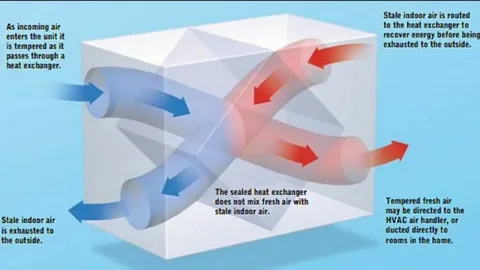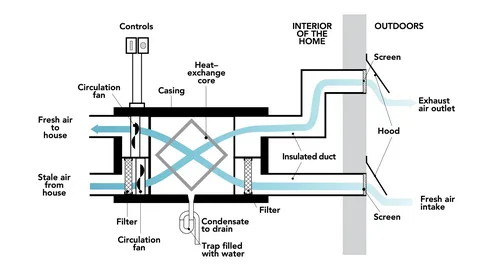Are you looking for ways to improve the air quality in your home? An air recovery ventilation system could be the solution you’re looking for. They are designed to reduce energy costs and maintain the air quality in your home. It have many advantages, from improved indoor air quality to reduced energy costs.
Heat Recovery Can Help Reduced Allergies And Asthma
If you or a loved one suffers from allergies or asthma, you know how debilitating these conditions can be. Sneezing, coughing, and wheezing can all make it difficult to lead a normal life, and many people struggle to relieve their symptoms. One potential solution to this problem is to install a heat recovery in your home.
The ventilation systems are designed to filter the air that enters your home, removing many of the allergens and pollutants that can trigger allergic reactions and exacerbate asthma symptoms. By circulating fresh, clean air throughout your living space, these systems can help reduce the amount of dust, pet dander, mould, and other irritants that can make life miserable for those with respiratory issues.
In addition, air recovery ventilation systems can also help regulate humidity levels in your home. It is important because high humidity levels can encourage mould growth and other fungi, further exacerbating allergy and asthma symptoms. An air ventilation system can help keep your indoor air quality at its best by keeping humidity levels within a safe range.
So if you or a loved one suffers from allergies or asthma, consider installing a ventilation system in your home. It can help alleviate symptoms and improve your overall quality of life and save you money on energy bills and help protect your home from damage caused by excess moisture. It’s a win-win for everyone involved!
 Heat Recovery Unit Can Increased Energy Efficiency
Heat Recovery Unit Can Increased Energy Efficiency
One of the top benefits of using a heat recovery unit is that it can significantly increase energy efficiency in your home or building. Heat recovery within the system works by transferring heat from the outgoing air to the incoming fresh air, meaning that your home’s heating and cooling systems will not need to work as hard to maintain the desired temperature.
It means that you will see a reduction in your energy bills and, ultimately, in your carbon footprint. Using a ventilation system can also help reduce the overall energy demand of your home, which can benefit the environment as a whole.
By recovering heat that would otherwise be lost, your HVAC system can operate more efficiently, which means less energy is consumed. As a result, you can reduce your carbon footprint and enjoy the financial benefits of reduced energy costs.
Investing in a ventilation system is smart for those looking to reduce their energy consumption, increase energy efficiency, and ultimately reduce their environmental impact. Not only will you benefit from lower energy bills, but you can also feel good about doing your part to protect the planet.
Whole House Ventilation System Can Improved Indoor Air Quality
If you’re concerned about the quality of the air you breathe in your home, a whole house ventilation system could be the solution you need. These systems are designed to continuously bring fresh outdoor air into your home while expelling stale indoor air. It helps to remove any pollutants or contaminants that may be present in the air, making it cleaner and healthier to breathe.
One of the main benefits of improved indoor air quality is its positive impact on your health. Poor air quality can contribute to various health issues, including allergies, respiratory problems, and even heart disease. By installing a whole house ventilation system, you can help to reduce your risk of these health problems and breathe easier in your home.
Another benefit of improved indoor air quality is the potential for increased productivity and better sleep. When the air in your home is clean and fresh, you’re less likely to experience fatigue, headaches, and other symptoms that can make it difficult to focus or relax. It can help you to get more done during the day and sleep better at night, improving your overall quality of life.
Finally, a whole house ventilation system can also help reduce the dust and other particles in your home. It can be especially beneficial for people with allergies or respiratory issues, as it can help to minimize the impact of allergens and irritants on their health.
Reduced Radon Levels
Radon is a radioactive gas that can seep into buildings through the soil and foundation. Long-term radon exposure can cause lung cancer. One of the benefits of using air recovery ventilation systems is that they can reduce the radon levels in a building.
By constantly exchanging stale air with fresh air from outside, an air ventilation system can help dilute the radon concentration in a building. It is especially important in areas with high radon levels in the soil.
In addition, some air recovery ventilation systems are equipped with a feature called Radon Mitigation Mode. This mode can be activated when the system detects high radon levels, and it can increase the airflow rate to further reduce the radon concentration.
Overall, by reducing the radon levels in a building, air recovery ventilation systems can help create a healthier living environment for the occupants.
The Air Recovery System Can Reduced Volatile Organic Compounds
Volatile organic compounds (VOCs) are harmful gases emitted from many common household items such as paint, cleaning products, and furniture. These chemicals can harm our health and the environment, causing respiratory problems and air pollution. An air recovery system can help reduce VOCs in the home by continuously filtering out stale air and bringing in fresh, filtered air.
An air recovery system uses a heat exchanger to transfer heat from the outgoing stale air to the incoming fresh air. It reduces heating costs and filters out pollutants and other unwanted particles, including VOCs. Filtering the air before it enters the home ensures that your family is breathing in clean, fresh air that is free of harmful pollutants.
Using a ventilation system can be especially beneficial for those who suffer from allergies or respiratory issues, as the reduced VOCs can help improve their symptoms. Bringing in the fresh air also helps to keep the indoor environment fresh and pleasant, reducing odours and making the home a more pleasant place to be.
Mechanical Heat Recovery Has Greater Comfort
Air recovery ventilation systems offer more than just improved air quality and energy efficiency. They can also provide greater comfort throughout your home. Mechanical heat recovery is a key feature that contributes to this comfort.
The recovery unit works by exchanging heat between the indoor and outdoor air. In the winter, the system transfers heat from the warm indoor air to the incoming cold outdoor air, while in the summer, it does the opposite. This means that the air being brought into your home is already partially heated or cooled, reducing the workload of your heating and cooling system.
The heat recovery system helps maintain a more comfortable temperature all year round. It results in more consistent temperatures throughout your home, eliminating cold and hot spots. No more waking up in the middle of the night shivering because your bedroom is too cold or sweating in your living room because it’s too hot.
Additionally, the system works quietly and unobtrusively, so you won’t even know it’s there. No drafty areas are caused by cold air rushing in from outside, and you won’t hear the sound of a noisy air conditioning unit kicking on and off.
Hrv System Cost Savings
Another great benefit of the hrv system cost savings. While these systems require an initial investment, they can help you save money in the long run.
Firstly, they are incredibly energy-efficient. By using the heat from stale indoor air to pre-heat incoming fresh air, these systems reduce the need for heating and cooling systems to work as hard, ultimately reducing your energy bills.
Poor indoor air quality has been linked to various health problems, including respiratory illnesses and allergies. Investing in an air system can help reduce the risk of these health issues, potentially saving you money on medical bills and medications. Additionally, improved indoor air quality can lead to savings in medical costs.
While air recovery vent systems may have an upfront cost, their long-term benefits can lead to significant cost savings for homeowners. By reducing energy bills and potentially reducing health-related costs, these systems are an investment in your home and your wallet.
Conclusion
Overall, air recovery ventilation systems have many benefits that can greatly improve your home or workplace. These systems can reduce allergies and asthma, increase energy efficiency, improve indoor air quality, and even lower radon levels. Using an air recovery ventilation system can also reduce volatile organic compounds and provide greater comfort. Additionally, these systems can save you money on your energy bill.



